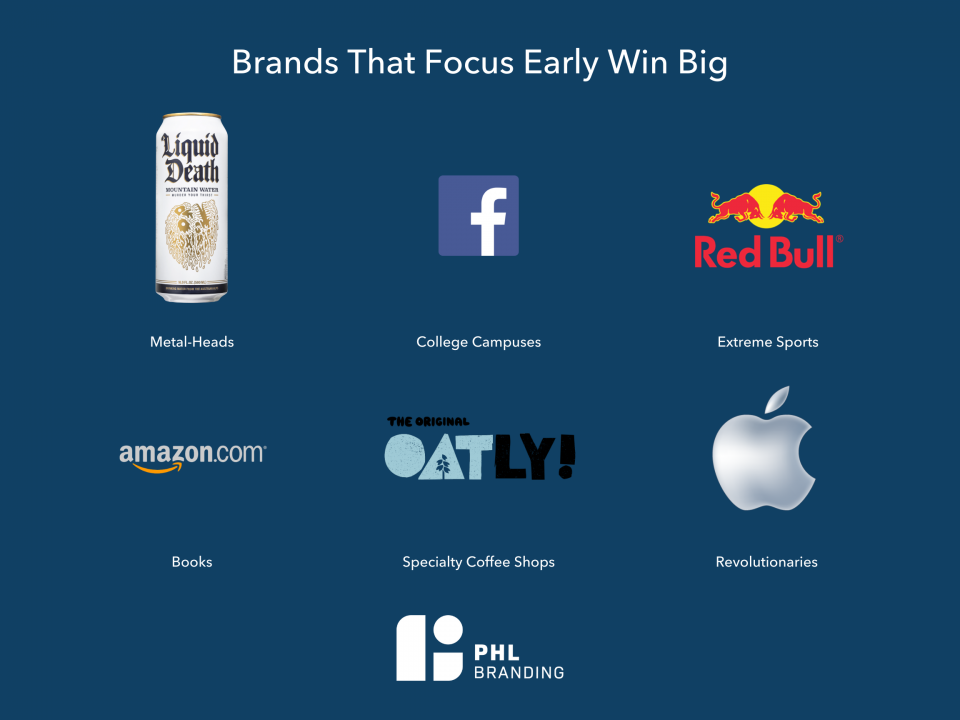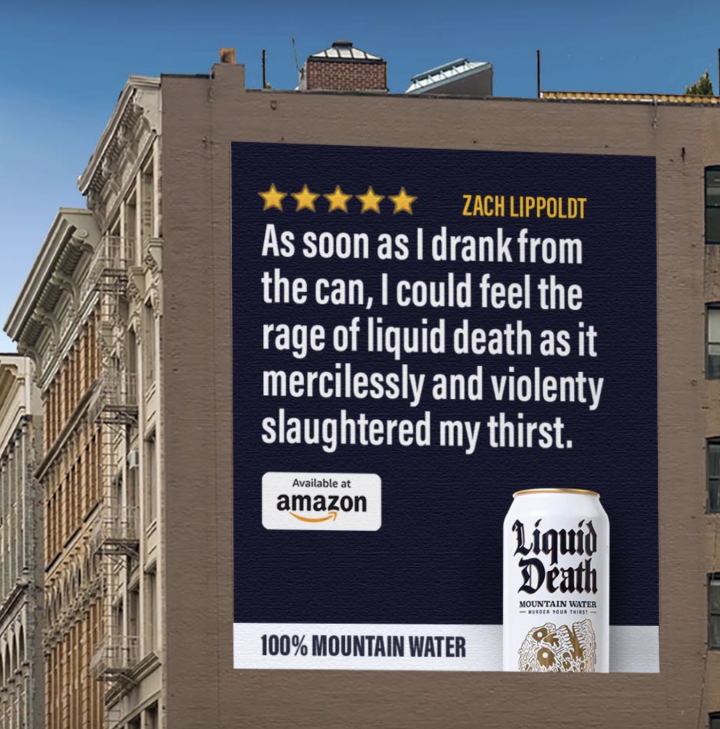The word “murder” isn’t exactly marketing gold. It’s not an idea that’s synonymous with “great brand affinity,” and it isn’t a sentiment that captures the hearts and minds of a broad swath of customers.
And yet, for a brand called Liquid Death – a company literally selling water in a can – the slogan of “Murder Your Thirst” is a big reason for being able to raise over $11 million dollars, gather over 96,000 Instagram followers and even accrue 20 customers who have tattooed the brand on their bodies (talk about brand affinity).
In reality, it’s not (just) the slogan “Murder Your Thirst” that’s working so well for Liquid Death. The slogan is, in fact, part of a broader business and marketing lesson rooted in the idea of focus. In Liquid Death’s case, that focus is a clear target audience: Metalheads and punk-rock fans.
Focus is the simplest concept in the world to understand, and yet, it’s the hardest thing for companies to implement. The reason? When we focus, we are shutting out 99% of the market in order to build a brand and experience tailored to the remaining 1%. It’s a scary thing to do – after all, we want more customers, not less!
You don’t have to look far, though, to find brands who focused in order to win. Facebook walled itself off from everyone but college campuses. Red Bull focused on extreme sports fanatics. Amazon began by selling books. Oatly – the darling of the oat milk world – started by marketing to specialty coffee shops. And Apple did its thing for the revolutionaries of the world.
(The list goes much, much longer, but, ya know, that whole “keep your articles short,” thing.)

So, what’s the benefit of focus? Without further ado, let’s take a look at Liquid Death and how they use focus to their advantage:
Advantage 1: When You Focus, a World of Tactics Opens Up Before You
Say you wanted to market an everyday water brand. What would you do? Well, you’d probably make an average logo, do the whole website thing with some generic copy, maybe turn on a little digital advertising and build some sales support.
But what happens when you create a water brand focused on metalheads and punk-rock fans? Well, now you can get creative.
Maybe you’ll create vinyl albums featuring your “Greatest Hates”. Maybe you’ll make a viral Covid-19 contest while everyone is stuck at home, awarding Liquid Death and 6 months of rent to the skateboarder who most effectively murders their house. Heck, maybe you’ll hire a real witch doctor on Halloween to curse your entire inventory.
It would be easy to say that Liquid Death is “just really creative” – but that’s not giving them enough credit. They have a clear brand strategy, they know and understand their audience, and they use that understanding as a springboard for some killer (yup) creativity.
Advantage 2: When You Focus, Your Brand Can Feel and Sound Different

Which message is more interesting? “Canned Water is better for the environment,” or “#DeathToPlastic”?
Clearly, that’s a rhetorical question.
By having a focused audience, Liquid Death gets the opportunity to sound a certain way. They get to say things like “Murder Your Thirst,” or “#DeathToPlastic.” When they give you an offer, you don’t say “Yes” or “No”, you choose whether or not to “Axe the Offer.” When you subscribe to their Country Club you decide whether or not to “Sell Your Soul”.
Knowing who your audience is means you have an immediate shortcut to relevant differentiation – you won’t just stand out, you’ll stand out in a way that’s relevant to your audience.
Focus = A Community of Customers
Liquid Death’s focus doesn’t just give it a clear target customer – it gives it a clear target community. That means its brand can be less reliant on expensive paid advertising, and instead slant heavily towards social media and word of mouth. After all, isn’t someone into the goth/metal scene more likely to follow a brand that serves its water in a coffin point-of-sale display? And if you feel like that brand truly knows you, aren’t you more likely to share it with all your fellow metalheads on and off of social media?
Interestingly, the community focus makes Liquid Death more newsworthy as well. Why wouldn’t the Washington Post write a story titled “These aluminum cans are totally metal: Liquid Death Sells Water to Punks Who Are Too Cool for Alcohol.”
What You Can Do with These Lessons
We never thought we’d write this sentence, but: You can learn a lot from Liquid Death. Here are four of the most important lessons to apply to your own business and marketing:
- Adjust your mindset: It can be scary to focus because you’re walling yourself off from the broader market. This requires a mindset shift – instead of saying “we are focused on one audience,” try sizing the overall market instead. For instance, say your brand wants to focus on summer boardsporters. Feels narrow, right? Well, that market is actually a nearly $20 billion industry – more than enough for most businesses. Shift your mindset to realize that the world is a big place, and small is actually more than enough for your brand to handle.
- Know thy audience: Once you’ve gotten over the “focus hump,” the fun part begins. Because you have a narrow audience, you get to go deep into their heads. Do research to understand the ins and outs of your customer. Where do they reside? What are their hobbies? What are the words and phrases that only they would know? Every insight you glean from this research should feed directly into the brand experience you design.
- Be insanely singular: You didn’t go through the exercise of convincing your team to focus just so that you could sound like everyone else, right? Now that you know your core audience, you get to write, design and innovate solely for “them” – your audience. If there’s anything you can learn from Liquid Death, it’s that your brand identity has to be delivered with crystal clarity across every single thing you say and do.
- When all else fails, test: No one believes you? Do a test. Throw a small sum of money at a completely narrow target audience that you already know very well. Execute in a way that would be relevant to them. Then, watch the reaction, prove the concept and extrapolate out from there. A little bit of traction can go a long way towards proving a broader business concept. A test is a great way to give actual momentum to a really smart idea.



